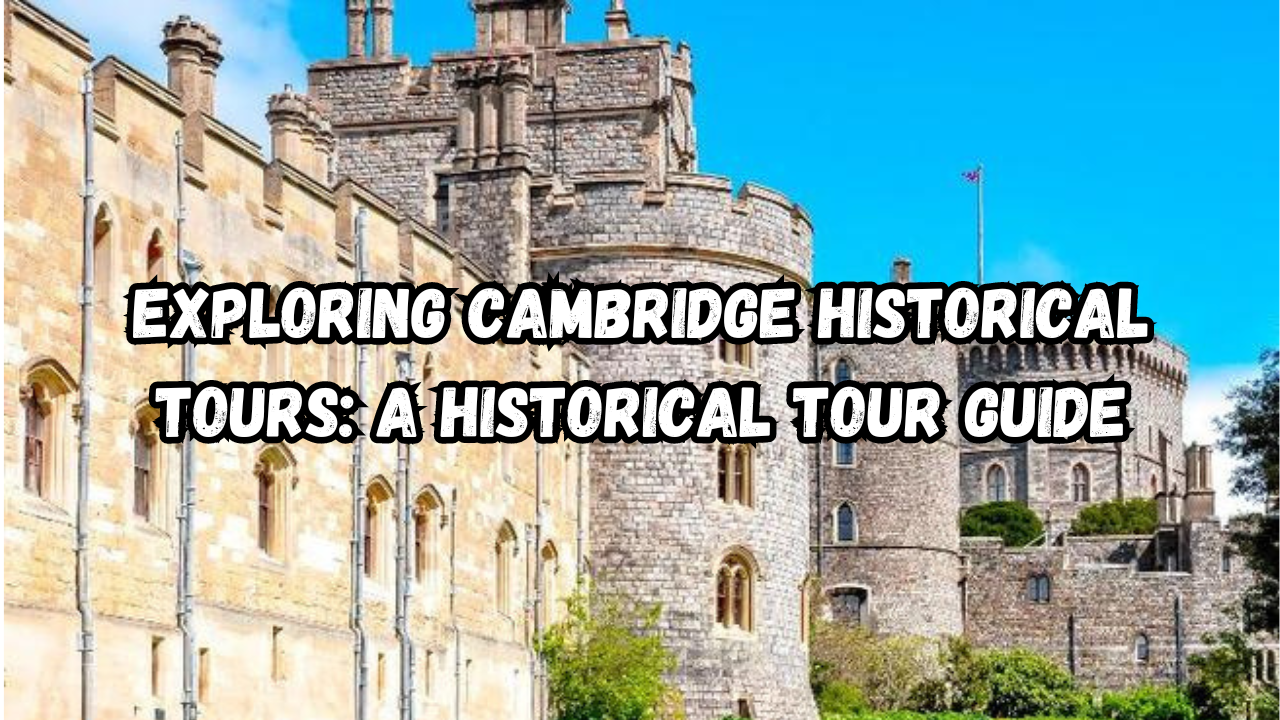
Introduction
Overview of Cambridge’s Rich History
Cambridge historical tours, renowned worldwide for its prestigious university, boasts a history that spans centuries. From its early days as a Roman trading post to its current status as a hub of education and innovation, Cambridge has played a pivotal role in shaping the intellectual and cultural landscape of Britain and beyond. The city’s rich historical tapestry is woven with stories of influential figures, groundbreaking discoveries, and architectural marvels, making it a fascinating destination for history enthusiasts.
Importance of Historical Tours in Cambridge
Historical tours in Cambridge are more than just a leisurely activity; they are an immersive journey through time. These tours offer invaluable insights into the city’s past, providing context to its present and future. By exploring the cobbled streets, ancient buildings, and storied landmarks, visitors can gain a deeper understanding of the significant events and personalities that have shaped Cambridge. Moreover, these tours help preserve the city’s heritage, fostering a sense of appreciation and responsibility towards conserving its historical assets.
Purpose and Structure of the Guide
This comprehensive guide aims to be the ultimate companion for anyone looking to explore Cambridge’s historical treasures. Whether you are a first-time visitor or a seasoned traveler, this guide will provide you with detailed information and practical tips to enhance your experience. The guide is structured to cover every aspect of Cambridge’s historical tours, from iconic landmarks and hidden gems to seasonal events and accessibility tips. Each section is designed to be mutually exclusive and collectively exhaustive, ensuring that all relevant information is included without redundancy. By the end of this guide, you will be well-equipped to embark on an enriching journey through the captivating history of Cambridge.
The Charm of Cambridge
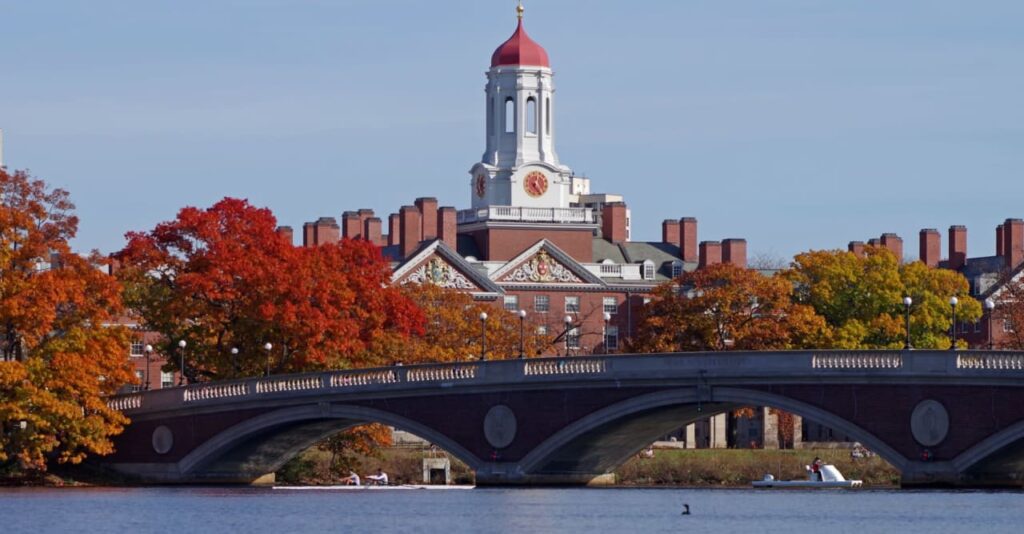
The Unique Appeal of Cambridge
Cambridge is a city that effortlessly blends the old with the new. Its picturesque landscapes, characterized by the River Cam, lush gardens, and centuries-old architecture, create a serene and inspiring environment. The city’s charm lies not only in its physical beauty but also in its intellectual vibrancy. Home to the University of Cambridge, one of the oldest and most esteemed universities in the world, the city is a beacon of learning and innovation. The blend of academic prestige, historical depth, and cultural richness gives Cambridge a unique appeal that attracts visitors from all over the globe.
Historical Significance of Cambridge
Cambridge’s historical significance is profound and multifaceted. As a settlement dating back to the Roman era, Cambridge has evolved through numerous historical epochs, each leaving an indelible mark on the city. The establishment of the University of Cambridge in 1209 was a pivotal moment, transforming the city into an epicenter of education and scholarly activity. Over the centuries, Cambridge has been a crucible for scientific and intellectual advancements, contributing significantly to fields such as physics, biology, and literature. Notable figures such as Sir Isaac Newton, Charles Darwin, and Stephen Hawking have all been part of Cambridge’s illustrious history, underscoring the city’s role in shaping modern thought and knowledge.
Key Periods in Cambridge’s History
Roman and Anglo-Saxon Periods
Cambridge’s history dates back to Roman times when it served as an important trading post. The Anglo-Saxon period saw the establishment of the town’s early Christian heritage, with the founding of monasteries and churches.
Medieval Era
The medieval era was marked by the founding of the University of Cambridge in 1209. This period saw the construction of many of the university’s iconic colleges and buildings, which remain central to the city’s architectural heritage.
Renaissance and Enlightenment
The Renaissance and Enlightenment periods were times of significant intellectual and cultural development in Cambridge. The city became a hub for scientific discovery, with luminaries such as Isaac Newton making groundbreaking contributions.
Industrial Revolution
While Cambridge remained primarily an academic town, the Industrial Revolution brought changes in infrastructure and connectivity. The arrival of the railway in the 19th century enhanced the city’s accessibility and growth.
Modern Era
In the modern era, Cambridge continues to be at the forefront of innovation and research. The city is a leader in the technology and biotech industries, often referred to as the “Silicon Fen.” This period also emphasizes the preservation and celebration of Cambridge’s rich historical heritage, ensuring that its past remains an integral part of its identity.
Getting Started with Cambridge Historical Tours
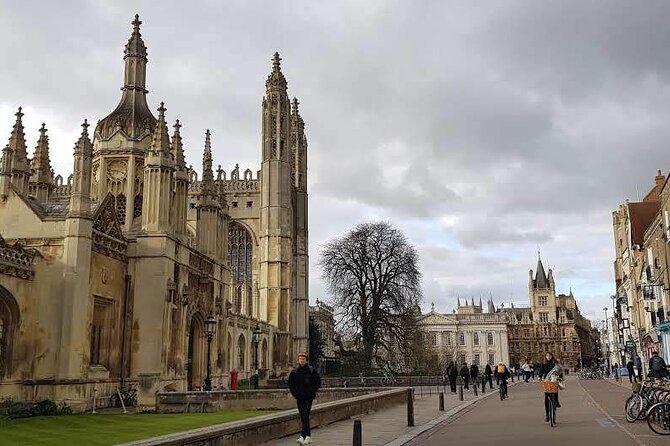
Planning Your Visit
Planning your visit to Cambridge is essential for a fulfilling historical tour experience. Start by determining the best time to visit, ideally during the spring and summer months when the weather is favorable, and the gardens are at their most beautiful. Plan to stay for at least 2-3 days to fully explore the city’s rich historical offerings. Choose centrally located accommodations to minimize travel time, and consider the best travel options, such as a direct train from London or renting a bicycle for local travel.
Types of Historical Tours Available
Cambridge offers a variety of historical tours to suit different interests. Walking tours are popular for their immersive experience, focusing on themes like university history and architecture. Punting tours on the River Cam provide a unique view of the colleges and bridges, with guides sharing historical insights. Museum tours at places like the Fitzwilliam Museum delve into specific historical collections. For active visitors, cycling tours cover more ground and offer broader city overviews. Private and custom tours provide a personalized experience tailored to specific interests and schedules.
Essential Tips for Tourists
To ensure a smooth and enjoyable tour, consider these essential tips. Book your tours and accommodations in advance, especially during peak seasons. Wear comfortable shoes for extensive walking on cobbled streets. Check the opening hours of colleges and museums, as they may have specific visiting times or be closed during university exams. Bring a camera to capture the stunning architecture and picturesque views. Stay hydrated and carry snacks to keep your energy up during long tours. Finally, respect the sites, many of which are still in use by students and faculty, by following any posted rules and maintaining a respectful attitude.
Iconic Landmarks of Cambridge Historical Tours
University of Cambridge
History and Significance
The University of Cambridge, established in 1209, is one of the oldest and most prestigious universities in the world. Its foundation marked a significant moment in the history of education, creating a center for learning and research that has influenced academia globally. Over the centuries, the university has been at the forefront of intellectual development, producing groundbreaking research and contributing to various fields such as science, literature, and philosophy. The university’s rich history is reflected in its stunning architecture, ancient traditions, and the numerous historical documents and artifacts preserved within its colleges and libraries.
Key Colleges to Visit
The University of Cambridge is comprised of 31 autonomous colleges, each with its own unique history and character. Among the most notable colleges to visit are:
- King’s College: Founded in 1441 by King Henry VI, it is renowned for its magnificent chapel, which is an architectural masterpiece of Gothic design. The chapel’s stunning stained glass windows and fan-vaulted ceiling are must-see features.
- Trinity College: Established in 1546 by King Henry VIII, Trinity is the largest of the Cambridge colleges. It boasts beautiful courts, the Wren Library with its vast collection of manuscripts, and a rich academic history.
- St. John’s College: Founded in 1511 by Lady Margaret Beaufort, this college is known for its picturesque Bridge of Sighs, the impressive chapel, and the stunning Great Gate.
- Corpus Christi College: Dating back to 1352, it is one of the oldest colleges and home to the Parker Library, which houses an exceptional collection of medieval manuscripts.
Notable Alumni and Their Contributions
The University of Cambridge has produced an array of notable alumni who have made significant contributions to various fields:
- Sir Isaac Newton: A mathematician and physicist who formulated the laws of motion and universal gravitation, Newton’s work laid the foundation for classical mechanics and advanced the scientific revolution.
- Charles Darwin: The naturalist who developed the theory of evolution by natural selection, Darwin’s seminal work, “On the Origin of Species,” has had a profound impact on biology and the understanding of life on Earth.
- Stephen Hawking: A theoretical physicist known for his work on black holes and cosmology, Hawking’s contributions to science and his book “A Brief History of Time” have inspired millions around the world.
- Lord Byron: The Romantic poet whose works, such as “Don Juan” and “Childe Harold’s Pilgrimage,” are celebrated for their imaginative and emotional depth, making a lasting impact on literature.
These distinguished individuals are just a few examples of the many influential thinkers and innovators who have studied at Cambridge, contributing to its reputation as a premier institution for higher education and research.
King’s College Chapel
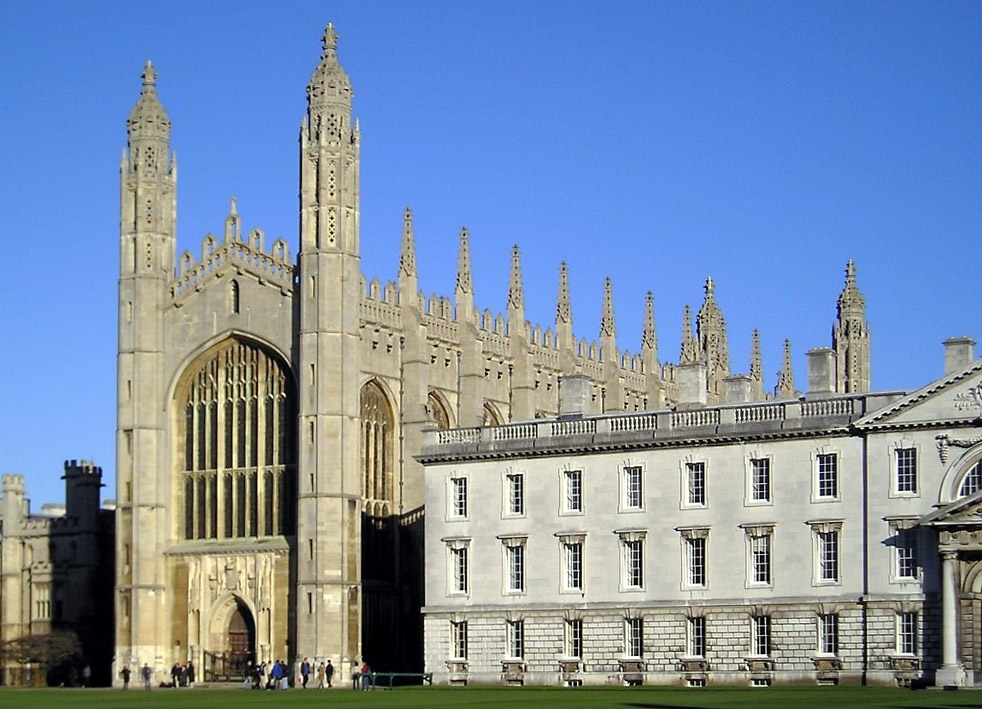
Architectural Marvels
King’s College Chapel, one of the most iconic structures in Cambridge, is celebrated for its stunning Gothic architecture. Construction began in 1446 under the reign of King Henry VI and was completed in 1515 during the reign of King Henry VIII. The chapel’s exterior is marked by its intricate stonework, tall spires, and large stained glass windows that create an awe-inspiring facade. Inside, the chapel boasts the world’s largest fan-vaulted ceiling, a masterpiece of engineering and design. The elaborate wooden screen, known as the Rood Screen, was added by King Henry VIII and features Tudor roses and pomegranates, symbolizing his marriage to Anne Boleyn. The chapel’s stained glass windows, installed between 1515 and 1531, are renowned for their vivid colors and detailed biblical scenes, making them some of the finest examples of medieval stained glass in England.
Historical Events
King’s College Chapel has been the site of numerous significant historical events over the centuries. During the English Civil War, the chapel was spared from destruction due to its religious significance and the intervention of the Earl of Manchester. The chapel also played a role in World War II; its stained glass windows were removed and stored for protection, only to be reinstalled after the war. One of the chapel’s most famous traditions is the annual Christmas Eve service, “A Festival of Nine Lessons and Carols,” which has been held since 1918 and broadcast globally, bringing the chapel’s beauty and the spirit of the holiday to millions of listeners worldwide.
Visiting Information
Visiting King’s College Chapel is a highlight of any trip to Cambridge. The chapel is open to visitors throughout the year, though hours may vary depending on the university calendar and special events. It’s recommended to check the King’s College website for the most up-to-date visiting times and ticket information. Guided tours are available and provide valuable insights into the chapel’s history, architecture, and significance. Visitors are encouraged to attend one of the choral services to experience the chapel’s renowned acoustics and the beautiful sounds of the King’s College Choir. Photography is allowed, but it’s important to be respectful of the space, especially during services. The chapel is accessible to those with mobility issues, with ramps and assistance available as needed. A visit to King’s College Chapel offers a profound glimpse into the architectural and historical heritage of Cambridge.
The Fitzwilliam Museum
Overview of Collections
The Fitzwilliam Museum, often referred to as “the Fitz,” is the principal art and antiquities museum of the University of Cambridge. Founded in 1816, the museum houses an extensive and diverse collection that spans centuries and continents. Its vast collections include artifacts from ancient Egypt, Greece, and Rome, as well as European paintings, manuscripts, and decorative arts. The museum’s impressive assemblage of art and antiquities offers visitors a comprehensive overview of human creativity and achievement across different cultures and historical periods.
Must-See Exhibits
When visiting the Fitzwilliam Museum, several exhibits are particularly noteworthy:
- Egyptian Galleries: These galleries showcase a remarkable collection of Egyptian artifacts, including mummies, tomb treasures, and intricately carved statues. The sarcophagi and the Book of the Dead fragments are especially fascinating.
- Greek and Roman Antiquities: Featuring sculptures, pottery, and coins, these collections provide a glimpse into the ancient civilizations of Greece and Rome. The marble busts and intricate mosaics are highlights.
- European Paintings: The museum’s collection of European paintings is outstanding, featuring works by renowned artists such as Titian, Rembrandt, Van Dyck, and Gainsborough. The Impressionist and Post-Impressionist sections, with works by Monet, Degas, and Cézanne, are particularly popular.
- Manuscripts and Rare Books: The Fitzwilliam’s library houses an extraordinary collection of illuminated manuscripts, rare books, and musical scores. The medieval manuscripts, adorned with gold leaf and vibrant illustrations, are among the most exquisite.
- Asian Art: This collection includes beautiful examples of Chinese ceramics, Japanese prints, and Indian textiles. The intricacy and craftsmanship of these pieces provide insight into the rich artistic traditions of Asia.
Historical Importance
The Fitzwilliam Museum holds significant historical importance, both as a repository of cultural heritage and as an institution of learning. It was founded by Richard, 7th Viscount Fitzwilliam of Merrion, who bequeathed his vast art collection and library to the University of Cambridge. The museum’s establishment marked a major contribution to the preservation and study of art and antiquities in Britain. Over the years, the Fitz has grown through numerous donations and acquisitions, continually expanding its collections and enhancing its role as a center for research and education. The museum’s collections provide invaluable resources for scholars and students, contributing to the understanding of art history and cultural studies. Furthermore, the Fitzwilliam Museum serves as a cultural landmark in Cambridge, attracting visitors from around the world and enriching the city’s vibrant artistic community.
Cambridge Market Square
Historical Background
Cambridge historical tours Market Square is a vibrant and historically significant location at the heart of the city. The market has been a central feature of Cambridge since the 13th century, with its origins tracing back to a charter granted by King Richard I in 1201. This charter allowed the townspeople to hold a market, which soon became a crucial part of the city’s economy and social life. Over the centuries, the market has evolved, reflecting changes in trade, commerce, and local culture. Today, it remains a bustling hub where history and contemporary life intersect, preserving the essence of its medieval origins while catering to modern needs.
Market Traditions and Activities
Cambridge Market Square is renowned for its diverse range of market stalls and vibrant atmosphere. Traditionally, the market has been a place for local farmers, artisans, and traders to sell their goods. Today, visitors can find a wide array of products, including fresh produce, baked goods, flowers, and artisanal crafts. The market is also known for its eclectic selection of street food from various international cuisines, making it a popular spot for both locals and tourists to sample delicious fare. Additionally, special events and seasonal markets are held throughout the year, including Christmas markets and summer festivals, adding to the square’s dynamic cultural scene.
Tips for Visitors
To make the most of your visit to Cambridge Market Square, consider these tips:
- Visit Early: Arriving early will give you the best chance to explore the full range of stalls and avoid the busiest crowds. The market typically starts early in the morning and runs until late afternoon.
- Bring Cash: While many vendors accept card payments, some may prefer cash. It’s a good idea to carry some cash for small purchases and to support local vendors.
- Check for Special Events: Look out for any special events or seasonal markets that might coincide with your visit. These events can offer unique products and experiences not available during regular market days.
- Explore the Surroundings: The Market Square is surrounded by historic buildings, shops, and cafes. Take some time to wander around the area, enjoy a coffee at a local cafe, or explore nearby landmarks.
- Respect Market Etiquette: Be mindful of the busy environment and respect vendors’ spaces. If sampling food or products, do so courteously and follow any signs or instructions.
- Weather Considerations: The market is held outdoors, so dress appropriately for the weather. Bring an umbrella or raincoat if rain is forecast, and wear comfortable shoes for walking.
Exploring Cambridge’s Historical Pubs
Historical Pubs of Cambridge
The Eagle Pub: WWII History
The Eagle Pub, located on Bene’t Street, is one of Cambridge’s most famous historical pubs, renowned for its significant role during World War II. The pub gained fame as a meeting place for RAF pilots and other military personnel during the war. It was here that, in 1943, a group of American airmen, including the future President of the United States, John F. Kennedy, gathered to share stories and experiences. The pub’s walls are adorned with wartime memorabilia, and its back room, known as the “RAF Bar,” features signatures and messages from those who frequented the pub during the war. The Eagle’s rich history is a testament to its role as a social hub during a pivotal time in history.
The Anchor: Literary Connections
The Anchor, situated on Silver Street, boasts a rich literary history, closely associated with notable figures from the world of literature. The pub is famously linked to the poet and playwright Christopher Marlowe, who is said to have frequented the establishment during his time at Cambridge University. The Anchor’s location along the River Cam provides picturesque views that have inspired many writers and artists over the years. The pub’s warm, historic ambiance and literary connections make it a charming spot for visitors interested in Cambridge’s rich literary heritage.
Other Notable Historical Pubs
- The Pickerel Inn: Located on Magdalene Street, The Pickerel Inn is one of the oldest pubs in Cambridge, with origins dating back to the 17th century. The pub is known for its traditional charm and historical significance, offering a glimpse into Cambridge’s past with its period decor and cozy atmosphere.
- The Crown & Punchbowl: Situated in the nearby village of Horningsea, The Crown & Punchbowl has a long history dating back to the 18th century. The pub is renowned for its historical architecture and serves as a reminder of rural life in the Cambridge area over the centuries.
- The Cambridge Blue: Located on Gwydir Street, The Cambridge Blue is celebrated for its role in local history and its commitment to preserving traditional pub culture. It has been a popular meeting place for students, locals, and visitors alike, reflecting the diverse social fabric of Cambridge.
Famous Bridges of Cambridge
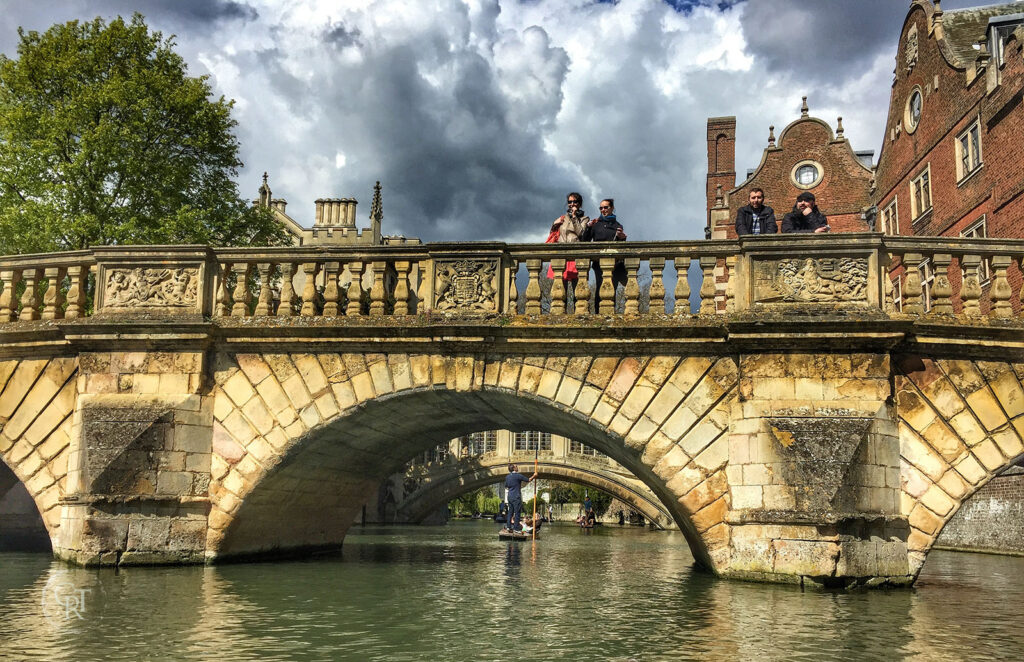
The Mathematical Bridge
Engineering Feats
The Mathematical Bridge, located at Queens’ College, is renowned for its innovative engineering design. Completed in 1749 by the carpenter and engineer James Essex, the bridge is a marvel of structural engineering. The bridge’s design uses a series of intersecting wooden arches, creating a strong yet visually light structure. The mathematical precision involved in its construction is evident in the way the arches distribute weight and support each other, allowing the bridge to span the River Cam without the need for visible supports. This design was considered revolutionary at the time and remains an impressive example of early engineering ingenuity.
Legends and Myths
The Mathematical Bridge is also steeped in local legends and myths. One popular but incorrect myth suggests that the bridge was built using only mathematical principles, without the use of any nails or bolts. According to this tale, the bridge was assembled by using only the mathematical knowledge of the builders, who could have dismantled it and reassembled it perfectly without any instructions. In reality, while the bridge’s design is mathematically impressive, it did involve traditional woodworking techniques. The legend adds an element of mystique to the bridge, enhancing its allure as a historical landmark.
The Bridge of Sighs
Historical Context
The Bridge of Sighs, located at St. John’s College, is named after the famous Bridge of Sighs in Venice due to its similar appearance. Completed in 1831, the bridge connects two parts of the college and is an architectural homage to Venetian design. The name “Bridge of Sighs” reflects a romanticized notion of the bridge’s function, as it was thought to be a place where students would sigh over their academic trials. Historically, the bridge served a practical purpose, facilitating movement between different parts of the college and contributing to the college’s architectural unity.
Architectural Features
The Bridge of Sighs is a fine example of Gothic Revival architecture. Designed by architect Henry Hutchinson, the bridge features a decorative stone facade with pointed arches and intricate detailing, evoking the grandeur of Venetian architecture. The bridge’s elegant appearance and picturesque setting over the River Cam make it one of the most photographed and admired landmarks in Cambridge. Its design complements the surrounding college buildings, creating a harmonious blend of history and architecture that enhances the visual appeal of St. John’s College.
Walking Tours of Cambridge
Popular Walking Tour Routes
Cambridge historical tours offer a chance to explore the city’s rich history and stunning architecture. Popular routes include the University and Colleges Tour, which covers the major colleges such as King’s and Trinity; the Historic City Centre Walk, focusing on historic streets and landmarks; and the Literary and Intellectual Cambridge route, highlighting sites connected to famous writers and thinkers.
Guided vs. Self-Guided Tours
Guided tours provide expert insights and detailed historical context, often including access to restricted areas and interactive elements. Self-guided tours offer flexibility, allowing visitors to explore at their own pace with the help of maps or audio guides. Both options have their advantages, depending on the visitor’s preference for structure or independence.
Highlights of Walking Tours
Key highlights of walking tours include the impressive architecture of Cambridge’s colleges, historic landmarks such as the Guildhall and the Fitzwilliam Museum, notable pubs like The Eagle and The Anchor, and scenic views along the River Cam and college gardens.
Punting on the River Cam
History of Punting
Punting on the River Cam is a traditional activity with origins in the 19th century. Punts are flat-bottomed boats propelled by pushing a pole against the riverbed, a technique well-suited to the shallow waters of the Cam. Punting has become a quintessential part of the Cambridge experience, offering unique views of the city’s landmarks.
Best Punting Routes
Popular punting routes include the College Loop, which passes several prestigious colleges; The Backs, offering picturesque views of college gardens and buildings; and the Mathematical Bridge Route, showcasing architectural landmarks along the river.
Tips for an Enjoyable Experience
To enhance your punting experience, dress comfortably, check the weather, book in advance, listen to your guide’s instructions if on a guided tour, and be mindful of your balance on the boat.
Historical Figures of Cambridge
Isaac Newton
Isaac Newton, a key figure in the scientific revolution, studied at Trinity College. His groundbreaking work on the laws of motion and universal gravitation has profoundly impacted the field of physics and established the foundation for classical mechanics.
Charles Darwin
Charles Darwin, who studied at Christ’s College, is renowned for his theory of evolution by natural selection. His work “On the Origin of Species” revolutionized the understanding of biological diversity and evolution.
Other Influential Personalities
Other notable Cambridge figures include Stephen Hawking, known for his work on black holes and cosmology; Sylvia Plath, an influential poet and novelist; and John Maynard Keynes, an economist whose ideas shaped modern economic theory and policy.
Hidden Gems and Lesser-Known Sites
The Round Church
The Round Church, officially known as the Church of the Holy Sepulchre, is one of Cambridge’s most unique and historic buildings. Dating back to the 12th century, this church is notable for its distinctive round shape, inspired by the Church of the Holy Sepulchre in Jerusalem. It is one of only four round churches remaining in England and is renowned for its medieval architecture and historical significance. Inside, visitors can admire ancient stonework, intricate carvings, and a small museum showcasing the church’s history.
Wren Library
The Wren Library, located at Trinity College, is an architectural masterpiece designed by Sir Christopher Wren. Completed in 1695, the library is renowned for its elegant Baroque design and impressive collection of manuscripts and rare books. Highlights include original works by Sir Isaac Newton and other notable scholars. The library’s ornate interior, with its vaulted ceilings and wooden paneling, offers a glimpse into the grandeur of 17th-century academic life.
Other Hidden Historical Sites
Cambridge is home to several lesser-known historical sites, including:
- The Museum of Archaeology and Anthropology: Located in the Old Schools, this museum features collections from around the world, including artifacts from ancient civilizations.
- Little St Mary’s Church: A small but historically rich church known for its medieval wall paintings and tranquil setting.
- The Old Courtroom: Situated at the Guildhall, this historic courtroom offers a glimpse into Cambridge’s legal history and its role in the local community.
Seasonal Tours and Events
Summer Festivals and Activities
Summer in Cambridge is vibrant with a range of festivals and activities. The Cambridge Science Festival and Cambridge Folk Festival are highlights, attracting visitors with their diverse programs. Seasonal tours often include special events such as garden tours at various colleges and open-air theater performances. The warmer months also provide ideal conditions for punting on the River Cam and exploring the city’s outdoor attractions.
Winter Historical Tours
Winter in Cambridge offers a quieter, more reflective experience. Winter historical tours include visits to historic sites adorned with seasonal decorations and festive events. The annual Christmas markets and winter illuminations add a magical touch to the city, while guided tours provide insights into Cambridge’s history and traditions during the colder months.
Special Events Throughout the Year
Cambridge hosts numerous special events throughout the year, including:
- The Cambridge Shakespeare Festival: An annual event featuring performances of Shakespeare’s plays in the beautiful setting of the college gardens.
- The Cambridge Literary Festival: Celebrating literature with author talks, readings, and discussions.
- The Cambridge Open Studios: Offering an opportunity to explore local artists’ studios and exhibitions.
Educational Tours for Students
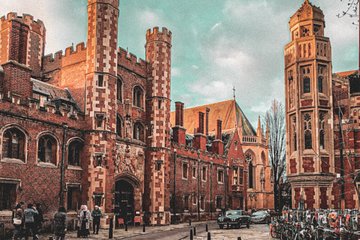
School and University Tour Packages
Educational tours in Cambridge are tailored for students, providing immersive experiences that combine learning with exploration. School and university tour packages often include guided tours of historic colleges, museums, and other significant sites. These packages can be customized to fit curriculum requirements and educational goals, offering a comprehensive understanding of Cambridge’s historical and cultural heritage.
Educational Benefits of Historical Tours
Historical tours provide valuable educational benefits by enhancing students’ understanding of history, architecture, and culture. They offer real-world context to classroom learning, foster critical thinking, and engage students with interactive experiences. By exploring historical sites and participating in educational activities, students gain a deeper appreciation for historical events and figures.
Organizing Educational Visits
Organizing educational visits to Cambridge involves coordinating with local institutions, booking guided tours, and planning logistics. It’s important to work with educational tour providers who can tailor the experience to meet specific learning objectives and ensure a smooth visit. Schools and universities should consider factors such as group size, itinerary, and any special requirements to maximize the educational value of the trip.
Family-Friendly Historical Tours
Kid-Friendly Tour Options
Family-friendly Cambridge historical tours offer engaging and educational experiences for children. Options include interactive tours designed specifically for younger audiences, such as scavenger hunts and themed storytelling sessions. Many historical sites, like the Fitzwilliam Museum and the University Botanic Garden, offer family-friendly programs with hands-on activities and educational workshops tailored to children’s interests and learning levels.
Engaging Activities for Children
To make historical tours enjoyable for kids, many tours incorporate engaging activities such as:
- Interactive Exhibits: Museums often feature interactive displays where children can touch and explore artifacts.
- Guided Tours with Stories: Tours that include storytelling elements or historical reenactments can captivate children’s imaginations and make learning fun.
- Educational Games: Activities like puzzles or quizzes related to historical facts can make the tour more engaging and memorable for young visitors.
Family Discounts and Offers
Many historical sites and tour providers in Cambridge offer family discounts and special offers. These can include reduced entry fees for children, family passes, or group rates. It’s advisable to check with individual attractions or tour operators in advance to find the best deals and ensure a cost-effective and enjoyable visit for the entire family.
Accessible Historical Tours
Tours for People with Disabilities
Accessible historical tours in Cambridge are designed to accommodate individuals with disabilities. These tours often include features such as wheelchair-accessible routes, audio guides for the visually impaired, and assistance from knowledgeable staff. Many historical sites in Cambridge strive to provide inclusive experiences, ensuring that all visitors can enjoy the city’s rich history and architecture.
Accessible Routes and Attractions
Cambridge offers several accessible routes and attractions, including:
- The Fitzwilliam Museum: Equipped with ramps, elevators, and accessible restrooms.
- King’s College Chapel: Provides access for visitors with mobility challenges.
- The University Botanic Garden: Features accessible paths and garden areas.
Resources for Accessible Travel
Resources for accessible travel in Cambridge include:
- Local Tourist Information Centers: Provide details on accessibility and can help with planning.
- Disability-Friendly Guides: Many attractions offer guides or websites detailing accessibility features.
- Assistive Services: Some tour providers offer specialized services, such as sign language interpreters or sensory guides.
Photography Tips for Historical Tours
Best Spots for Historical Photos
For capturing the beauty and history of Cambridge, consider photographing:
- Iconic Buildings: The Mathematical Bridge, King’s College Chapel, and St. John’s College offer stunning architectural shots.
- Scenic Views: The Backs, with its picturesque college gardens along the River Cam, provides excellent photo opportunities.
- Historic Pubs: Capture the charm of historic pubs like The Eagle and The Anchor, reflecting Cambridge’s rich history.
Tips for Capturing Architectural Details
To capture architectural details effectively:
- Use Different Angles: Experiment with various perspectives to highlight unique architectural features.
- Pay Attention to Light: Shoot during the golden hour for soft, flattering light, or use shadows and reflections to add depth.
- Focus on Details: Zoom in on intricate carvings, patterns, and textures to showcase the craftsmanship.
Ethical Photography Practices
When photographing historical sites:
- Respect Privacy: Avoid taking photos of people without their consent, especially in sensitive areas.
- Preserve the Site: Be mindful of barriers or restricted areas and avoid damaging or touching historical artifacts.
- Follow Rules: Adhere to any guidelines set by the site regarding photography, including restrictions on flash or tripods.
Culinary Delights of Cambridge
Historical Restaurants and Cafes
Cambridge boasts a selection of historical restaurants and cafes that offer both a taste of the city’s rich history and its local cuisine. Establishments such as The Eagle Pub and The Cambridge Blue have long histories and are integral to the city’s culinary landscape. The Eagle, for example, is famed for its WWII connections, while The Cambridge Blue offers a traditional pub experience with a menu featuring local dishes. Dining in these historical venues provides visitors with a unique blend of historical ambiance and contemporary comfort.
Traditional Cambridge Dishes
Traditional Cambridge dishes reflect the region’s culinary heritage. Cambridge Burnt Cream, a local variant of crème brûlée, is a popular dessert, while Cambridge Sausages are a savory delight made from a unique blend of spices and meats. Many local restaurants and cafes pride themselves on using traditional recipes and locally sourced ingredients, giving visitors a taste of authentic Cambridge cuisine. These dishes offer a glimpse into the local food culture and historical eating habits of the region.
Food Tours and Tastings
Food tours and tastings in Cambridge provide an opportunity to explore the city’s culinary scene in-depth. These tours often include visits to historic eateries, local markets, and specialty food shops. Participants can sample a variety of dishes and learn about the history and significance of local foods. Some tours are guided by culinary experts who share insights into Cambridge’s food traditions and highlight the best places to eat. This immersive experience not only satisfies the palate but also enriches the visitor’s understanding of the city’s gastronomic heritage.
Souvenirs and Shopping
Best Places to Buy Souvenirs
Cambridge historical tours, visitors should explore local markets and specialty shops. The Cambridge Market Square is a bustling hub where vendors sell a variety of keepsakes, from handmade crafts to local food products. King’s Parade and Trinity Street feature several shops offering Cambridge-themed memorabilia, including mugs, t-shirts, and academic-themed gifts. These locations provide a range of options for finding something special to remember your visit by.
Historical Shops and Markets
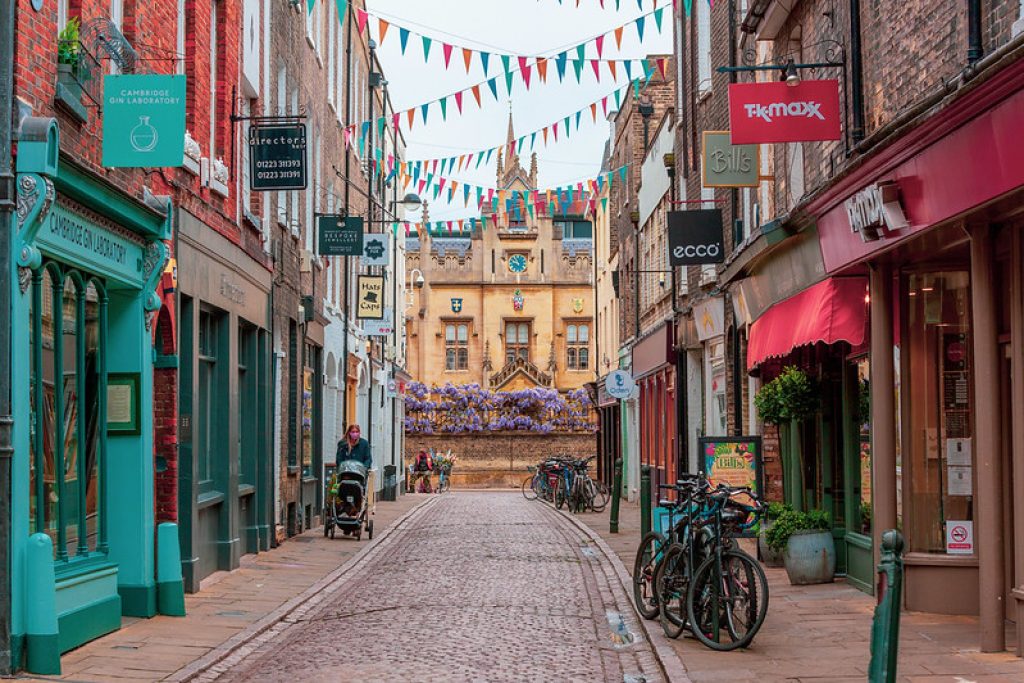
Cambridge’s historical shops and markets offer a nostalgic shopping experience. G. David Booksellers, for example, is a historic bookshop that has been serving Cambridge since 1921, offering rare and second-hand books. The Cambridge Cheese Company provides a selection of locally made cheeses and delicacies, reflecting the region’s artisanal food traditions. Shopping in these historical venues allows visitors to take home a piece of Cambridge’s rich heritage.
Unique Cambridge Keepsakes
Unique keepsakes from Cambridge include items like antique maps of the city, personalized college-themed gifts, and local art pieces. Other distinctive souvenirs might include handcrafted items from local artisans or historical prints and postcards that capture the essence of Cambridge’s architecture and landmarks. These keepsakes serve as lasting reminders of a visit to one of England’s most storied cities.
Safety and Etiquette on Historical Tours
Safety Tips for Tourists
When exploring historical sites in Cambridge, tourists should prioritize safety by staying aware of their surroundings and following local guidelines. It’s advisable to keep personal belongings secure and be cautious of uneven surfaces and crowded areas. Visitors should also be mindful of the weather conditions and dress appropriately for the season. Adhering to safety instructions provided by tour guides or signage at historical sites helps ensure a safe and enjoyable experience.
Respecting Historical Sites
Respect for historical sites is crucial to preserving their integrity and ensuring that future visitors can enjoy them. Tourists should avoid touching artifacts, climbing on structures, or disturbing sensitive areas. Following the rules and guidelines set by site managers helps protect these valuable cultural and historical assets. By treating these sites with care and respect, visitors contribute to their preservation and maintain the city’s rich heritage for future generations.
Tour Etiquette
Good tour etiquette enhances the experience for everyone involved. Visitors should be punctual, follow the guide’s instructions, and refrain from talking loudly or using mobile phones during tours. It’s also important to ask permission before taking photographs, especially in restricted areas. Showing courtesy to fellow tourists and staff, and being mindful of personal space, helps create a positive and respectful atmosphere during historical tours.
Summary
Cambridge Historical Tours, renowned for its rich history and academic heritage, offers a wealth of historical tours and experiences that showcase its illustrious past. From the iconic University of Cambridge, with its historic colleges and architectural marvels like King’s College Chapel, to the charming lesser-known sites such as The Round Church and the Wren Library, the city is a treasure trove of historical significance. Visitors can explore these landmarks through guided and self-guided tours, engage in seasonal events, and enjoy local culinary delights. Family-friendly and accessible tour options ensure that Cambridge’s history is open to everyone. Additionally, the city provides opportunities for unique souvenirs and memorable experiences. Exploring Cambridge not only offers a deeper understanding of its storied past but also contributes to preserving and celebrating its cultural heritage.
Recap of Key Points
Cambridge, a city rich in history and academic prestige, offers a wide range of historical tours and experiences. From walking tours of iconic colleges and landmarks to punting on the River Cam, the city’s historical offerings are diverse and engaging. Key sites include the University of Cambridge, with its historic colleges and notable alumni; the architectural marvels of King’s College Chapel and the Mathematical Bridge; and lesser-known gems like The Round Church and Wren Library. Family-friendly options, accessible tours, and seasonal events further enrich the visitor experience, while local culinary delights and unique souvenirs provide additional layers of enjoyment. Safety, respect for historical sites, and good etiquette are essential for ensuring a positive experience during these explorations.
Importance of Exploring Cambridge’s History
Exploring Cambridge’s history is essential for understanding the city’s profound impact on education, culture, and science. The historical tours and sites provide valuable insights into the origins of one of the world’s most prestigious universities, the evolution of architectural styles, and the lives of influential historical figures. Engaging with Cambridge’s rich past not only enhances one’s appreciation for its present but also contributes to preserving and honoring its heritage. Such exploration fosters a deeper connection to the city and enriches the overall travel experience.
Encouragement to Visit and Discover
Cambridge’s historical tours offer a unique opportunity to immerse oneself in a city steeped in tradition and academic excellence. Whether you are drawn to its storied colleges, scenic river punting, or vibrant local culture, Cambridge has something to captivate every visitor. We encourage you to visit and discover the myriad historical treasures the city has to offer. By exploring Cambridge, you not only gain a richer understanding of its past but also create memorable experiences that will stay with you long after your visit.
FAQs
What is the best time to visit Cambridge for historical tours?
The best time to visit Cambridge for historical tours is during the spring (April to June) and autumn (September to October) months. During these periods, the weather is generally mild and pleasant, making it ideal for walking tours and outdoor activities. Additionally, these seasons avoid the peak summer tourist crowds and the colder winter weather, offering a more comfortable and relaxed experience. However, if you’re interested in seasonal events and festivals, summer can also be a vibrant time to visit.
Are there any free historical tours available?
Yes, there are free historical tours available in Cambridge. Many organizations, including some local tour companies and the University of Cambridge, offer free walking tours of the city. These tours often rely on tips from participants, and they provide an excellent introduction to Cambridge’s history and landmarks. Additionally, some museums and historic sites offer free entry, allowing visitors to explore their exhibits without a charge.
How long should I plan for a comprehensive tour of Cambridge?
For a comprehensive tour of Cambridge, it is recommended to plan at least two to three days. This allows time to explore major landmarks such as the University of Cambridge and its colleges, visit notable sites like King’s College Chapel and The Fitzwilliam Museum, and enjoy activities such as punting on the River Cam. If you wish to experience additional aspects like food tours or seasonal events, extending your visit to four or more days would provide a more thorough and enjoyable experience.
Can I book tours in advance?
Yes, booking tours in advance is highly recommended, especially during peak tourist seasons or for specific tours that may have limited availability. Many tour operators and attractions offer online booking options, allowing you to secure your spot ahead of time. Advanced bookings also help ensure that you get the preferred tour times and avoid long queues or sold-out experiences.
Are tours available in multiple languages?
Yes, many historical tours in Cambridge are available in multiple languages. Tour operators often provide multilingual guides or offer audio guides in various languages to cater to international visitors. It’s advisable to check with specific tour providers in advance to confirm the availability of tours in your preferred language and to make arrangements as needed.



